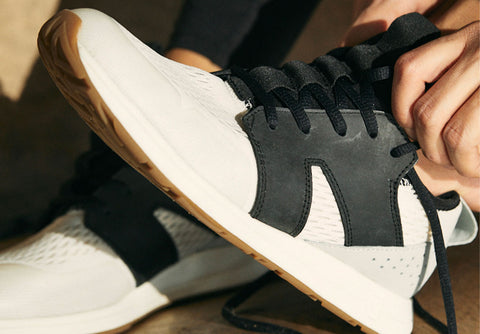11.17.21Dylan York
How Should Shoes Fit?

USA FREE SHIPPING $150+, FREE RETURNS & EXCHANGES

With 80 percent of men and 32 percent of women wearing the wrong shoe sizes, it shows that people buy shoes that don't fit. Whether oversized or undersized shoes, they pose more harm to your feet than you think.
It goes beyond normal sore toes to affecting your ankles, calves, hips or even spine. Wearing the wrong shoe sizes jeopardizes the healthiness of your feet — the wrong shoe sizes have been linked with a series of foot problems like corns, bunions, blisters, ingrown toes, and many more.

How should sneakers fit?
Just because a shoe will go onto your foot doesn’t mean that it is the proper size, ideally, you shouldn’t even feel it on your foot. There are three major factors that play a role in the proper shoe fit. You want to be cognizant of the length, width, and volume of a pair of shoes.
When trying on a pair of shoes and finding the right fit, there are a few easy tricks you can do to ensure a better fit.
Measure the length of your feet
It doesn't matter if you measured your feet last month while buying your everyday shoes. You'd be surprised to know that the size of your feet isn't constant — the size of your feet changes over time.
Speaking of the size of your feet, there are many things that can influence the size of your feet. Weight loss, weight gain or even time of the day affect the size of your feet. Your weight impacts the size, shape and width of your foot, so measure your feet whenever you want to get new running shoes or sneakers.
To a large number of people, one foot is usually larger than the other. Test your sneakers/running shoes in the larger foot for comfort while running or walking.
Ignoring your bigger foot causes your heels and toes to hurt badly, which slows down your pace.
Socks tend to make shoes tighter, and you'll be needing a pair of socks for your sneakers or running shoes. Wear your socks while testing both feet to see the level of slippage — space left in the shoe. It shouldn't be too tight or too loose.

Buy exactly what fits
It's the hope of shoe expansion that makes people buy undersized sneakers. Don't hope for the shoes to expand — go for what fits at the moment.
People put their feet through pains, hoping they'll grow into those pairs of shoes. And most of the time, it doesn't always go as planned. The shoes never expand, but they sure do get foot problems.
Always employ this simple rule when picking your sneakers or running shoes — if they don't fit, they aren't for your feet. You sure need the right running shoes to successfully carry out your athletic activities.
Consider shoe size depth, width and shape
You don't judge a pair of shoes by the external features alone. A pair of running shoes is the right fit when the size, depth and width fit your feet.
Width and volume/height of the shoe also play a part in giving comfort to your feet, and flexibility to your toes. If the shoes are too shallow, your toes will likely become sore when you run or walk on them. So, make sure they fit on every side.

How Should Running Shoes Fit?
Running shoes are athletic shoes designed to support and cushion your heels while providing your toes with flexibility. Running shoes need to be as comfortable as possible to enable you to run without having sore toes, aching heels, and sprained ankles. There is a common theory that your running shoes should be about a half size to a full size bigger than your everyday shoes due to the swelling and increased blood flow that comes from a workout. While that is based in some fact, the truth is that there are sizing variations between brands and types of shoes that can affect sizing.
You want to find the size that is most comfortable for you during your workout, you don’t want a shoe that is too loose and feels unstable, but you also don’t want it to feel tight and potentially reduce circulation to the foot.
Should My Toes Touch The End Of My Shoes?
Your toes touching the end of your shoes mean one thing — the pair isn't the right fit. The right pair of shoes should have a 3/8 of an inch of space between your toes to the end of your shoes.
The space makes your toes flexible for easy movement. Your toes brushing the end of your shoes causes calluses and sore toes. Buy shoes with the right slippage for a healthy foot.
There are few things to consider when knowing and how shoes should fit and finding the proper size for you. Having the right size shoe does more than just being stylish or looking appropriate and proportionate, but can easily influence your overall health, wellbeing, and daily comfort levels.
By creating an account, you agree to the Terms and Conditions and Privacy Policy of York Athletics.